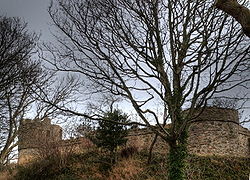| Aberlleiniog Castle | |
|---|---|
Castell Aberlleiniog | |
| Anglesey Near Llangoed in Wales, United Kingdom | |
 Two of the castle's towers and keep wall in 2009, after restoration had begun | |
| Site information | |
| Type | Castle |
| Open to the public | Yes |
| Condition | Ruined, Undergoing Restoration |
| Location | |
| Coordinates | 3166-2:GB-WLS 53°17′33″N4°4′38″W / 53.29250°N 4.07722°W |
| Site history | |
| Built | 1080–1099 |
| Built by | Hugh d'Avranches |
| In use | Late 11th Century-mid 17th Century |
Castell Aberlleiniog (Castle of the Mouth of the Lleiniog) is a motte and bailey fortress near the Welsh village of Llangoed on the Isle of Anglesey, built between 1080 and 1099 by Hugh d'Avranches, 1st Earl of Chester. It is about two miles distant from Beaumaris Castle, and was built atop a very steep hill.

